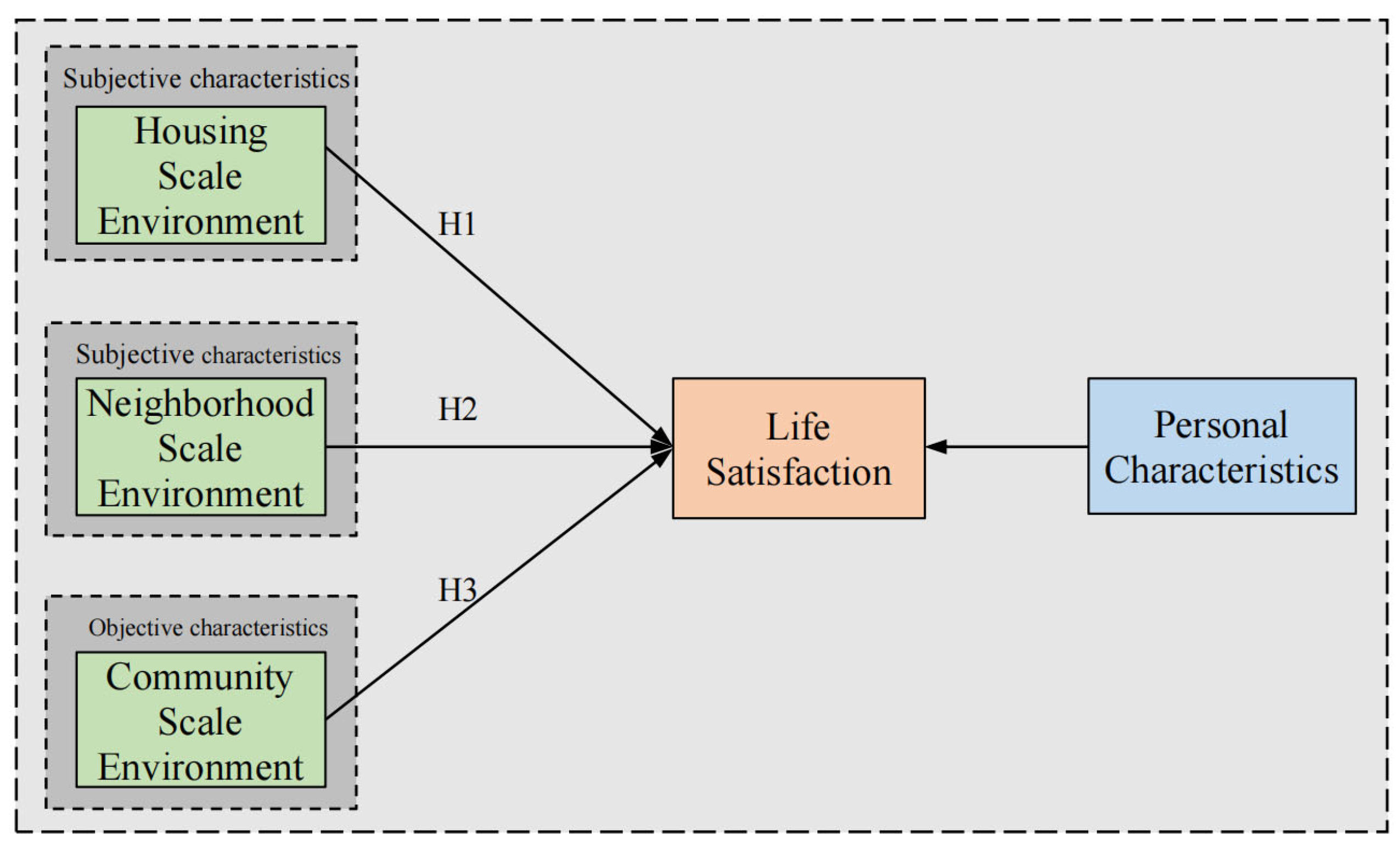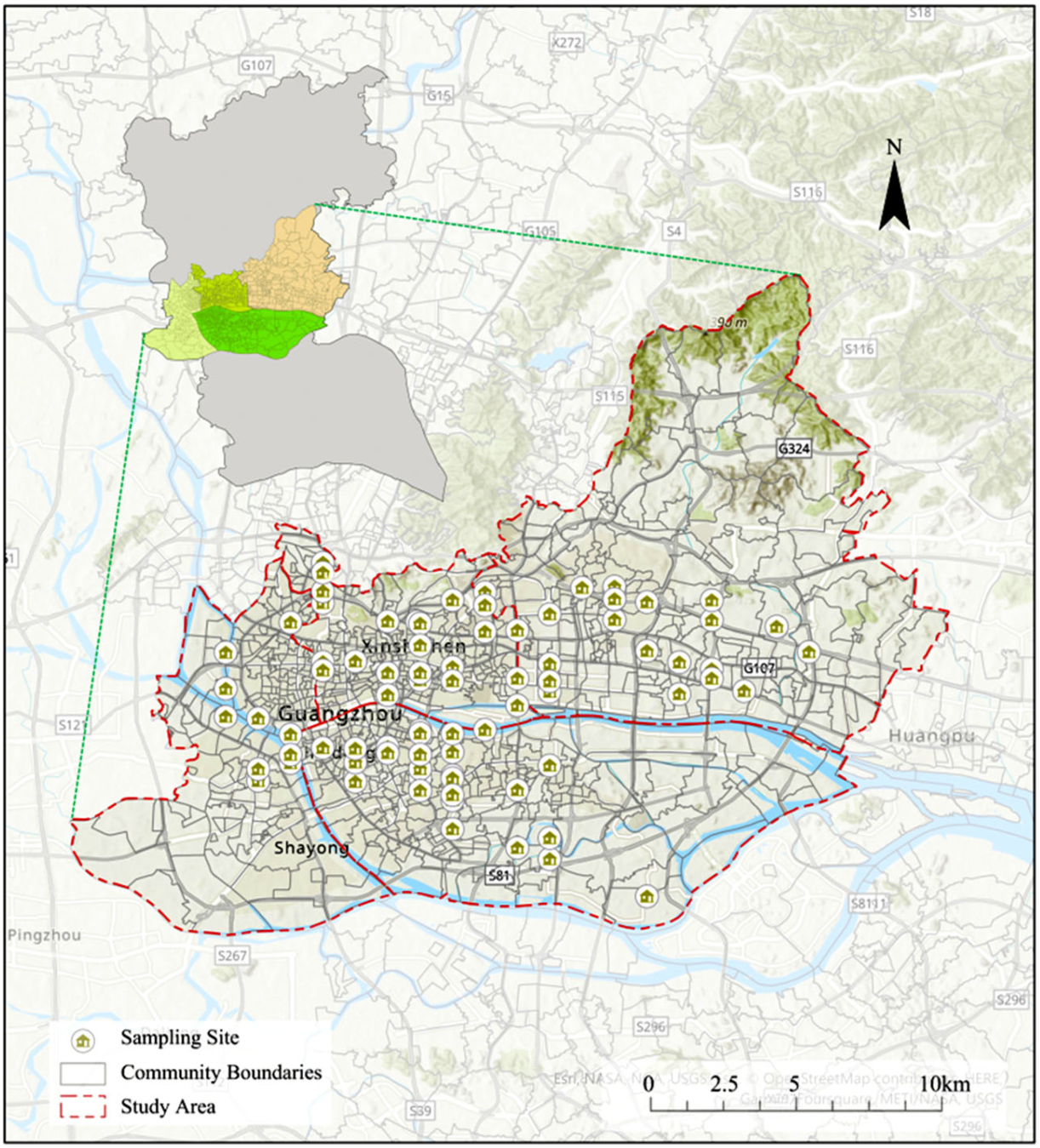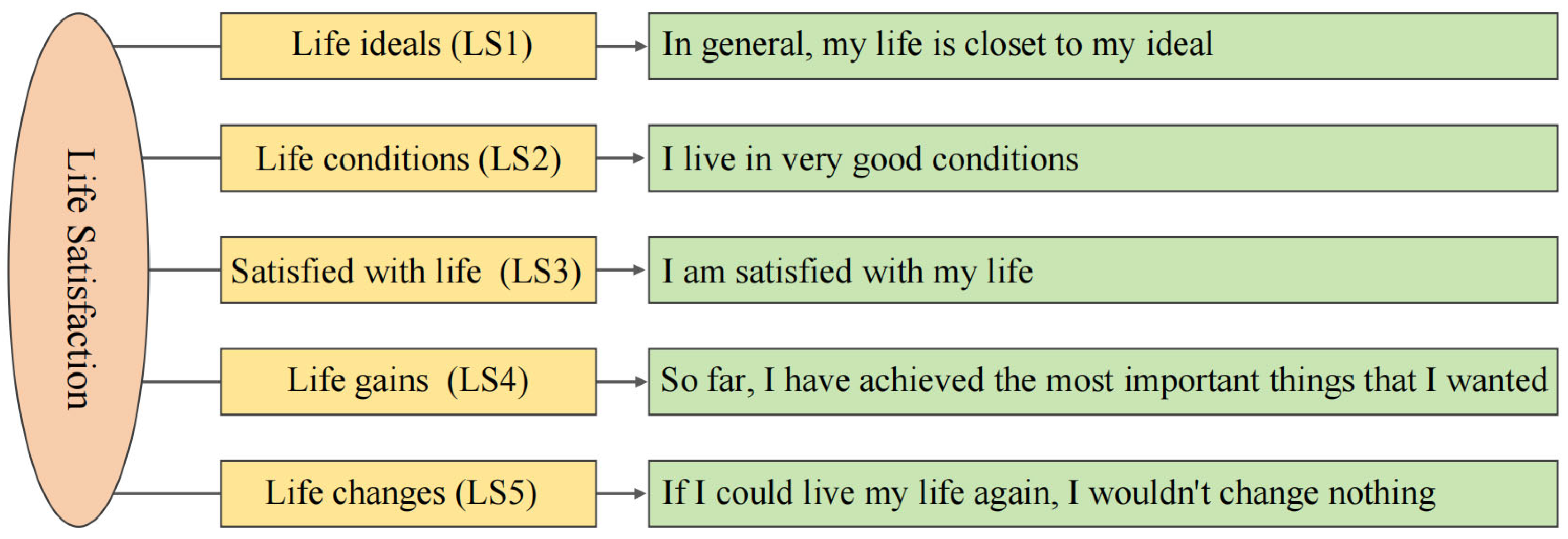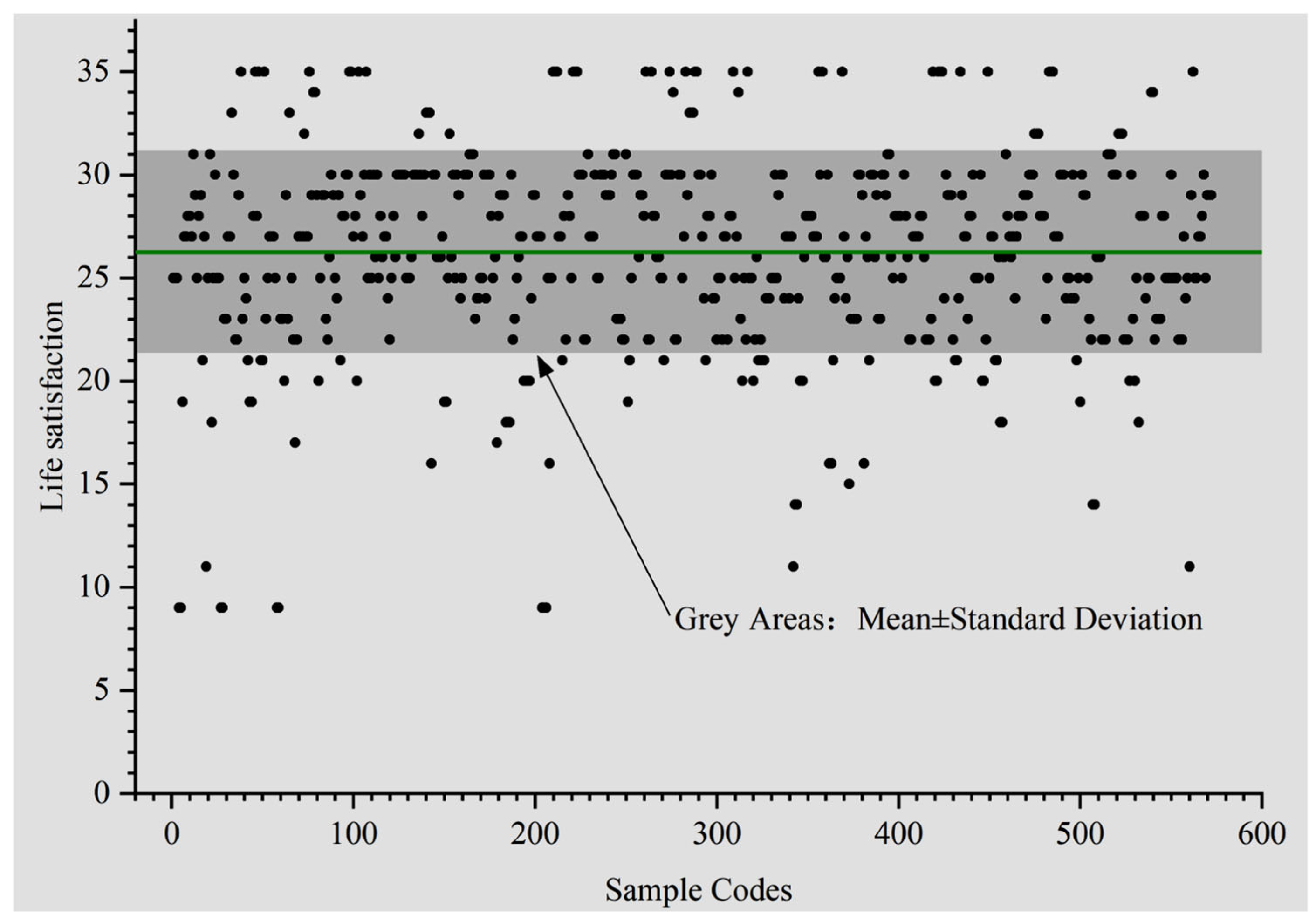Does the Multi-Scale Built Environment Impact on Residents’ Subjective Well-Being?
Abstract
1. Introduction
2. Literature Review and Model Development
2.1. Subjective Well-Being
2.2. Built Environment
2.3. The Factors Influencing Subjective Well-Being
2.4. Model Hypotheses
3. Methodology
3.1. Data Collection
3.2. Variables and Measurement
3.3. Reliability and Validity Testing
3.4. Model Specification
4. Results
5. Discussion
6. Conclusions and Recommendations
6.1. Conclusions
- (1)
- The explanatory power of the model for the dependent variable gradually increases with the increase in environmental variables such as housing, neighborhood, and community, after controlling the other variables. Notably, the results demonstrate that the explanatory ability has a hierarchical structure, and the housing environment shows the largest increase in explanatory ability, followed by the neighborhood environment, and finally the community environment;
- (2)
- In terms of the housing environment, the Housing Construction Environment and Quality Evaluation (HCEQE) and per capita housing area (HAPC) have a significant impact on residents’ life satisfaction, after controlling for other variables;
- (3)
- In terms of the neighborhood environment, the comfortable evaluation of the neighborhood environment (NECE) and facility evaluation (NFE) at the neighborhood scale significantly affect life satisfaction, while the property management and service evaluation (NPMSE) have significant negative impacts.
- (4)
- In terms of the community environment, building density (BD), functional mix density (FMD), road intersection density (RID), bus stop density (BSD), and bus line density (BLD) all significantly affect life satisfaction.
6.2. Theoretical and Practical Implications
- (1)
- Housing Scale—Greater emphasis should be placed on construction quality, architectural aesthetics, and interior layout design in housing development. Real estate policies should be optimized to guide housing prices within a reasonable range and increase per capita living space;
- (2)
- Neighborhood Scale—Planning and design should prioritize neighborhood environmental comfort (e.g., noise reduction, sanitation) and optimize the allocation of facilities such as leisure sports and fitness facilities, landscape and road lighting facilities, and parking facilities. Particular attention must be paid to carefully assessing the alignment between the content of property services and their fees. Enhancing service transparency and perceived fairness is crucial to avoid undermining resident well-being due to excessive financial burdens or perceived lack of value;
- (3)
- Community Scale—The urban planners and managers should focus on optimizing building density, reasonably planning functional configurations, and strengthening road intersection design. The planning of mixed-use developments and the deployment of public transport infrastructure must involve meticulous environmental impact assessment and urban design. The focus should be on mitigating potential negative externalities—such as noise, pollution, and safety risks—through design interventions (e.g., sound barriers, green buffer zones, rational stop layout). The goal is to realize the true life-enhancing benefits of Transit-Oriented Development (TOD) models, moving beyond merely pursuing density metrics. In addition, considering the important role of personality, it is necessary to establish a multi-dimensional propaganda system of “government–community–school–family” to promote the formation of an optimistic personality, and to enhance the subjective well-being and life satisfaction level of residents.
6.3. Research Limitions and Future Research Directions
Author Contributions
Funding
Data Availability Statement
Conflicts of Interest
References
- Yang, J.; Tao, Y.; Liu, Z.; Li, M.; Liu, J. The impact of neighborhood effects on community interaction and life satisfaction: A multi-level path analysis based on 26 community residents in Beijing. Hum. Geogr. 2021, 36, 27–34. [Google Scholar]
- Diener, E. (Ed.) The Science of Well-Being: The Collected Works of Ed Diene; Springer Science & Business Media: Berlin/Heidelberg, Germany, 2009; Volume 37. [Google Scholar]
- Diener, E.; Chan, M.Y. Happy people live longer: Subjective well-being contributes to health and longevity. Appl. Psychol. Health Well-Being 2011, 3, 1–43. [Google Scholar] [CrossRef]
- Zhan, D.; Zhang, W.; Yu, J.; Miao, C.; Liu, C. The spatial characteristics and mechanisms of urban livability based on objective evaluation: A case study of Beijing. Reg. Res. Dev. 2016, 35, 68–73. [Google Scholar]
- Brockmann, H.; Delhey, J.; Welzel, C.; Yuan, H. The China puzzle: Falling happiness in a rising economy. J. Happiness Stud. 2009, 10, 387–405. [Google Scholar] [CrossRef]
- Ma, J.; Liu, G.; Rao, J. Progress in the study of the impact of geographical environment and spatiotemporal behavior on subjective well-being. Prog. Geogr. 2022, 41, 718–730. [Google Scholar] [CrossRef]
- Cao, X.J. How does neighborhood design affect life satisfaction? Evidence from Twin Cities. Travel Behav. Soc. 2016, 5, 68–76. [Google Scholar] [CrossRef]
- Yuan, Y.; Ding, K.; Cao, X.; Zhu, Y.; Zhang, Y. A review of research methods on community satisfaction and influencing factors. Urban Dev. Stud. 2018, 25, 105–111. [Google Scholar]
- Mouratidis, K. Rethinking how built environments influence subjective well-being: A new conceptual framework. J. Urban. Int. Res. Placemaking Urban Sustain. 2018, 11, 24–40. [Google Scholar] [CrossRef]
- Fried, M. The structure and significance of community satisfaction. Popul. Environ. 1984, 7, 61–86. [Google Scholar] [CrossRef]
- Liu, X.; Wang, Z.; Song, J.; Liu, C.; Deng, M. The impact of residential environment on residents’ subjective well-being: An example from mixed residential communities in Shenzhen. Prog. Geogr. 2022, 41, 2099–2107. [Google Scholar] [CrossRef]
- Lee, S.M.; Conway, T.L.; Frank, L.D.; Cain, K.L.; Sallis, J.F. The relation of perceived and objective environment attributes to neighborhood satisfaction. Environ. Behav. 2017, 49, 136–160. [Google Scholar] [CrossRef]
- Kang, L.; Zhang, W. Influence of neighborhood social environment on residents’ well-being: A case study of typical low-income communities in Beijing city. Areal Res. Dev. 2021, 40, 50–55. [Google Scholar]
- Batson, C.D.; Monnat, S.M. Distress in the desert: Neighborhood disorder, resident satisfaction, and quality of life during the Las Vegas foreclosure crisis. Urban Aff. Rev. 2015, 51, 205–238. [Google Scholar] [CrossRef] [PubMed]
- Friedman, D.; Parikh, N.S.; Giunta, N.; Fahs, M.C.; Gallo, W.T. The influence of neighborhood factors on the quality of life of older adults attending New York City senior centers: Results from the Health Indicators Project. Qual. Life Res. 2012, 21, 123–131. [Google Scholar] [CrossRef]
- Huang, Y.; He, L. Urbanization, environmental pollution and subjective well-being: An empirical study on China. China Soft Sci. 2013, 12, 82–93. [Google Scholar]
- Sun, B.; Yin, C. Relationship between multi-scale urban built environments and body mass index: A study of China. Appl. Geogr. 2018, 94, 230–240. [Google Scholar] [CrossRef]
- Han, H.; Yang, K.; Yang, C.; Yang, G.; Xu, L. Influence and Mechanism of a Multi-Scale Built Environment on the Leisure Activities of the Elderly: Evidence from Hefei City in China. Int. J. Environ. Res. Public Health 2022, 19, 9237. [Google Scholar] [CrossRef]
- Yin, C.; Shao, C.; Dong, C.; Wang, X. Happiness in urbanizing China: The role of commuting and multi-scale built environment across urban regions. Transp. Res. Part D Transp. Environ. 2019, 74, 306–317. [Google Scholar] [CrossRef]
- Cao, X.; Wu, X.; Yuan, Y. Examining built environmental correlates of neighborhood satisfaction: A focus on analysis approaches. J. Plan. Lit. 2018, 33, 419–432. [Google Scholar] [CrossRef]
- Diener, E. Subjective well-being: The science of happiness and a proposal for a national index. Am. Psychol. 2000, 55, 34–43. [Google Scholar] [CrossRef] [PubMed]
- Ryan, R.M.; Deci, E.L. On happiness and human potentials: A review of research on hedonic and eudaimonic well-being. Annu. Rev. Psychol. 2001, 52, 141–166. [Google Scholar] [CrossRef]
- Pavot, W.; Diener, E. The satisfaction with life scale and the emerging construct of life satisfaction. J. Posit. Psychol. 2008, 3, 137–152. [Google Scholar] [CrossRef]
- Ryff, C.D. Happiness is everything, or is it? Explorations on the meaning of psychological well-being. J. Personal. Soc. Psychol. 1989, 57, 1069. [Google Scholar] [CrossRef]
- Kennes, A.; Peeters, S.; Janssens, M.; Goedhart, R.; Myin-Germeys, I.; Bastiaansen, T. Optimism and mental health in adolescence: A prospective validation study of the Dutch Life-Orientation Test-Revised (LOT-RA) for adolescents. Psychol. Belg. 2021, 61, 104–115. [Google Scholar] [CrossRef] [PubMed]
- Oishi, S. The psychology of residential mobility: Implications for the self, social relationships, and well-being. Perspect. Psychol. Sci. 2010, 5, 5–21. [Google Scholar] [CrossRef]
- Lin, X.; Yang, J. A review of the relationship between built environment and public health in North American metropolitan areas and its implications. Planner 2015, 31, 12–19. [Google Scholar]
- Uppal, S. Impact of the timing, type and severity of disability on the subjective well-being of individuals with disabilities. Soc. Sci. Med. 2006, 63, 525–539. [Google Scholar] [CrossRef]
- Jivraj, S.; Nazroo, J.; Vanhoutte, B.; Chandola, T. Aging and subjective well-being in later life. J. Gerontol. Ser. B Psychol. Sci. Soc. Sci. 2014, 69, 930–941. [Google Scholar] [CrossRef]
- Lamu, A.N.; Olsen, J.A. The relative importance of health, income and social relations for subjective well-being: An integrative analysis. Soc. Sci. Med. 2016, 152, 176–185. [Google Scholar] [CrossRef]
- Stutzer, A.; Frey, B.S. Recent advances in the economics of individual subjective well-being. Soc. Res. Int. Q. 2010, 77, 679–714. [Google Scholar] [CrossRef]
- Mhaoláin, A.M.N.; Gallagher, D.; Connell, H.O.; Chin, A.V.; Bruce, I.; Hamilton, F.; Teehee, E.; Coen, R.; Coakley, D.; Cunningham, C.; et al. Subjective well-being amongst community-dwelling elders: What determines satisfaction with life? Findings from the Dublin Healthy Aging Study. Int. Psychogeriatr. 2012, 24, 316–323. [Google Scholar] [CrossRef]
- Yu, Y.; Hu, Y. International research progress on the health impact of community built environment based on physical activity research perspective: A literature review and thoughts. Archit. J. 2017, 2, 33–38. [Google Scholar]
- Cervero, R.; Kockelman, K. Travel demand and the 3Ds: Density, diversity, and design. Transp. Res. Part D Transp. Environ. 1997, 2, 199–219. [Google Scholar] [CrossRef]
- Ewing, R.; Cervero, R. Travel and the built environment: A meta-analysis. J. Am. Plan. Assoc. 2010, 76, 265–294. [Google Scholar] [CrossRef]
- Srinivasan, S.; O’fallon, L.R.; Dearry, A. Creating healthy communities, healthy homes, healthy people: Initiating a research agenda on the built environment and public health. Am. J. Public Health 2003, 93, 1446–1450. [Google Scholar] [CrossRef] [PubMed]
- Dang, Y.; Yu, J.; Zhang, W.; Gao, S.; Wang, J. Evaluation and influencing factors of urban residential environment satisfaction in the Bohai Rim region. Prog. Geogr. 2016, 35, 184–194. [Google Scholar]
- Wei, Z.; Zhen, F.; Qin, X. Study on the quality of living environment and institutional influencing factors in Guangzhou’s affordable housing communities. Geogr. Sci. 2020, 40, 89–96. [Google Scholar]
- Arellana, J.; Saltarín, M.; Larrañaga, A.M.; González, V.I.; Henao, C.A. Urban walkability considering pedestrians’ perceptions of the built environment: A 10-year review and a case study in a medium-sized city in Latin America. Transp. Rev. 2020, 40, 183–203. [Google Scholar] [CrossRef]
- Campbell, A.; Converse, P.E.; Rodgers, W.L. The Quality of American Life: Perceptions, Evaluations, and Satisfactions; Russell Sage Foundation: New York, NY, USA, 1976. [Google Scholar]
- Sirgy, M.J.; Cornwell, T. How neighborhood features affect quality of life. Soc. Indic. Res. 2002, 59, 79–114. [Google Scholar] [CrossRef]
- Liu, Y.; Pan, Z.; Feng, J.; Li, Y.; He, S. Factors affecting emotional well-being of residents in low-rent housing in metropolises in China: A case study of Guangzhou. Trop. Geogr. 2019, 39, 180–187. [Google Scholar] [CrossRef]
- Li, Z. A study on residential satisfaction in “new immigrant” settlements in Chinese cities: A case study of Beijing, Shanghai, and Guangzhou. Urban Plan. 2011, 35, 75–82. [Google Scholar]
- Dekker, K.; De Vos, S.; Musterd, S.; Van Kempen, R. Residential satisfaction in housing estates in European cities: A multi-level research approach. Hous. Stud. 2011, 26, 479–499. [Google Scholar] [CrossRef]
- Liu, X.; Yu, Y. The impact of community built environment on the health of the elderly under high-density living conditions and intervention pathways. Urban Dev. Stud. 2023, 30, 35–42. [Google Scholar]
- Han, S. Social capital and subjective happiness: Which contexts matter? J. Happiness Stud. 2015, 16, 241–255. [Google Scholar] [CrossRef]
- Lin, J.; Sun, B. The impact of the built environment on the subjective well-being of urban residents: Evidence from the China Labor Dynamics Survey. Urban Dev. Stud. 2017, 24, 69–75. [Google Scholar]
- Melis, G.; Gelormino, E.; Marra, G.; Ferrero, G.; Costa, G. The effects of the urban built environment on mental health: A cohort study in a large northern Italian city. Int. J. Environ. Res. Public Health 2015, 12, 14898–14915. [Google Scholar] [CrossRef]
- Mason, S.G. Can community design build trust? A comparative study of design factors in Boise, Idaho neighborhoods. Cities 2010, 27, 456–465. [Google Scholar] [CrossRef]
- Cao, J. The association between light rail transit and satisfactions with travel and life: Evidence from Twin Cities. Transportation 2013, 40, 921–933. [Google Scholar] [CrossRef]
- Ma, J.; Dong, G.; Chen, Y.; Zhang, W.; Li, T. Does a satisfactory neighborhood environment lead to a satisfying life? An investigation of the association between neighborhood environment and life satisfaction in Beijing. Cities 2018, 74, 229–239. [Google Scholar] [CrossRef]
- Bardo, A.R. A life course model for a domains-of-life approach to happiness: Evidence from the United States. Adv. Life Course Res. 2017, 33, 11–22. [Google Scholar] [CrossRef]
- Su, L.; Zhou, S. The impact of neighborhood environment on happiness under the background of residential mobility: Differences across life course stages. Prog. Geogr. 2021, 40, 1344–1354. [Google Scholar] [CrossRef]
- Liu, Y.; Xiao, T.; Liu, Y.; Song, Y.; Li, Z. The impact of urban built environment on the happiness of residents in Guangzhou City: An analysis based on 15-min walkable range. Prog. Geogr. 2020, 39, 1270–1282. [Google Scholar] [CrossRef]
- Scheier, M.F.; Carver, C.S.; Bridges, M.W. Distinguishing optimism from neuroticism (and trait anxiety, self-mastery, and self-esteem): A reevaluation of the Life Orientation Test. J. Pers. Soc. Psychol. 1994, 67, 1063–1078. [Google Scholar] [CrossRef] [PubMed]
- Wen, Z. The reliability and validity of the Life Orientation Test in college students. Chin. J. Ment. Health 2012, 26, 305–309. [Google Scholar]
- Gu, H.; Wang, C. Statistical control of item wording effects: An example of the Chinese version of the Life Orientation Test. Psychol Sci. 2012, 35, 1247–1253. [Google Scholar]
- Diener, E.; Emmons, R.A.; Larsen, R.J.; Griffin, S. The satisfaction with life scale. J. Pers. Assess. 1985, 49, 71–75. [Google Scholar] [CrossRef]
- Feng, J.; Tang, S.; Chuai, X. The impact of neighborhood environments on the quality of life of elderly people: Evidence from Nanjing, China. Urban Stud. 2018, 55, 2020–2039. [Google Scholar] [CrossRef]
- Johnson, B.T.; Cromley, E.K.; Marrouch, N. Spatiotemporal meta-analysis: Reviewing health psychology phenomena over space and time. Health Psychol. Rev. 2017, 11, 280–291. [Google Scholar] [CrossRef] [PubMed]
- Grafström, A.; Tillé, Y. Doubly balanced spatial sampling with spreading and restitution of auxiliary totals. Environmetrics 2013, 24, 120–131. [Google Scholar] [CrossRef]
- Hair, J.F.; Money, A.H.; Samouel, P.; Page, M. Research methods for business. Educ. + Train. 2007, 49, 336–337. [Google Scholar] [CrossRef]
- Sekaran, U.; Bougie, R. Research Methods for Business: A Skill Building Approach, 7th ed.; John Wiley & Sons: Hoboken, NJ, USA, 2016. [Google Scholar]
- Hair, J.F., Jr.; Black, W.C.; Babin, B.J.; Anderson, R.E. Multivariate Data Analysis, 7th ed.; Prentice Hall: Upper Saddle River, NJ, USA, 2010. [Google Scholar]
- Kline, R.B. Principles and Practice of Structural Equation Modeling; Guilford Publications: New York, NY, USA, 2023; pp. 48–52. [Google Scholar]
- Neter, J.; Wasserman, W.; Kutner, M.H. Applied Linear Statistical Models: Regression, Analysis of Variance, and Experimental Designs, 3rd ed.; Irwin: Homewood, IL, USA, 1990. [Google Scholar]
- Batty, M.; Longley, P.A. Fractal Cities: A Geometry of Form and Function; Academic Press: Cambridge, MA, USA, 1994. [Google Scholar]
- Batty, M. The size, scale, and shape of cities. Science 2008, 319, 769–771. [Google Scholar] [CrossRef]
- Oliver, R.L. A cognitive model of the antecedents and consequences of satisfaction decisions. J. Mark. Res. 1980, 17, 460–469. [Google Scholar] [CrossRef]
- Kahneman, D.; Deaton, A. High income improves evaluation of life but not emotional well-being. Proc. Natl. Acad. Sci. USA 2010, 107, 16489–16493. [Google Scholar] [CrossRef] [PubMed]
- Hur, M.; Morrow-Jones, H. Factors that influence residents’ satisfaction with neighborhoods. Environ. Behav. 2008, 40, 619–635. [Google Scholar] [CrossRef]
- Graham, M.H. Confronting multicollinearity in ecological multiple regression. Ecology 2003, 84, 2809–2815. [Google Scholar] [CrossRef]
- Sussman, A.; Hollander, J.B. Cognitive Architecture: Designing for How We Respond to the Built Environment; Routledge: Oxfordshire, UK, 2021. [Google Scholar]
- Lavdas, A.A.; Salingaros, N.A.; Sussman, A. Visual attention software: A new tool for understanding the “subliminal” experience of the built environment. Appl. Sci. 2021, 11, 6197. [Google Scholar] [CrossRef]
- Lavdas, A.A. Eye-tracking applications in architecture and design. Encyclopedia 2024, 4, 1312–1323. [Google Scholar] [CrossRef]





| Variable | Type | Frequency | Percentage (%) |
|---|---|---|---|
| Age | 18–29 | 192 | 33.803 |
| 30–39 | 114 | 20.070 | |
| 40–49 | 77 | 13.556 | |
| 50–59 | 97 | 17.077 | |
| ≥60 | 88 | 15.494 | |
| Gender | Male | 291 | 51.232 |
| Female | 277 | 48.768 | |
| Marriage | Married | 343 | 60.387 |
| Single | 177 | 31.162 | |
| Divorced | 12 | 2.113 | |
| Other | 36 | 6.338 | |
| Occupation | Government, Institutions, or Public Service Workers | 69 | 12.148 |
| Company Employees | 159 | 27.993 | |
| Freelancers | 147 | 25.880 | |
| Retired Persons | 79 | 13.908 | |
| Students | 31 | 5.458 | |
| Other | 83 | 14.613 | |
| Education Level | Junior High School or Below | 129 | 22.711 |
| High School or Technical School | 149 | 26.232 | |
| College or University | 246 | 43.310 | |
| Postgraduate or Above | 44 | 7.747 | |
| Monthly Income (RMB) | ≤5000 | 214 | 37.676 |
| 5001–8000 | 153 | 26.937 | |
| 8001–10,000 | 73 | 12.852 | |
| 10,001–13,000 | 66 | 11.620 | |
| ≥13,001 | 62 | 10.915 |
| Variable | Scale | Description | Mean | SD |
|---|---|---|---|---|
| HNEE | Housing | Average score of two measurement items for ventilation and lighting conditions of the house | 5.676 | 1.102 |
| HCEQE | Housing | Average score of three measurement items for construction environment, construction quality, and appearance of the building | 5.411 | 1.147 |
| HLDE | Housing | Score for the evaluation of the house layout and design | 5.417 | 1.299 |
| HAPC | Housing | Per capita housing area | 2.712 | 1.625 |
| NECE | Neighborhood | Average score of two measurement items for quietness and sanitation environment within the neighborhood area | 5.152 | 1.303 |
| NFE | Neighborhood | Average score of three measurement items for sports and fitness facilities, parking facilities, and landscape lighting facilities | 5.060 | 1.327 |
| NPMSE | Neighborhood | Score for the evaluation of property management and services | 5.106 | 1.495 |
| PD | Community | Average population number within a 1000 m buffer zone (10,000 people/km2) | 4.318 | 2.305 |
| BD | Community | Ratio of the sum of building base areas to the occupied area within a 1000 m buffer zone | 0.311 | 0.074 |
| FMD | Community | Diversity of facilities such as hospitals, restaurants, convenience stores, shopping malls, schools, banks, entertainment facilities, tourism facilities, government and institutional facilities, and postal facilities within a 1000 m radius buffer zone, calculated as In the provided formula, the variable represents the proportion of POI belonging to category i relative to the total number of POI within the 1000 m radius buffer. The parameter n represents the total count of unique POI categories encompassed by this buffer. | 0.730 | 0.058 |
| RID | Community | Ratio of the number of main road intersections to the geographical unit area within a 1000 m buffer zone (km/km2) | 143.224 | 72.379 |
| BLD | Community | Ratio of the total length of bus lines to the geographical unit area within a 1000 m buffer zone (km/km2) | 8.489 | 3.169 |
| BSD | Community | Ratio of the number of bus stops and subway stations to the geographical unit area within a 1000 m buffer zone (units/km2) | 9.918 | 2.916 |
| POID | Community | Ratio of the total number of ten types of POI points such as accommodation, catering, shopping, leisure and entertainment, tourism, scientific research and education, government institutions, large shopping, financial services facilities to the geographical unit area within a 1000 m buffer zone (units/km2) | 361.799 | 211.412 |
| 1 | 2 | 3 | ||||
|---|---|---|---|---|---|---|
| B (SD) | β | B (SD) | β | B (SD) | β | |
| Housing Scale | ||||||
| HNEE | −0.046 (0.049) | −0.052 | −0.050 (0.048) | −0.056 | −0.067 (0.049) | -0.076 |
| HCEQE | 0.282 *** (0.049) | 0.332 | 0.225 *** (0.051) | 0.265 | 0.225 *** (0.051) | 0.265 |
| HLDE | 0.030 (0.038) | 0.039 | 0.028 (0.038) | 0.038 | 0.044 (0.039) | 0.059 |
| HAPC | 0.054 * (0.021) | 0.090 | 0.047 * (0.021) | 0.078 | 0.047 * (0.022) | 0.078 |
| Neighborhood Scale | ||||||
| NECE | 0.084 * (0.038) | 0.112 | 0.089 * (0.039) | 0.120 | ||
| NFE | 0.104 ** (0.039) | 0.142 | 0.102 * (0.040) | 0.139 | ||
| NPMSE | −0.084 ** (0.032) | −0.128 | −0.082 * (0.032) | −0.126 | ||
| Community Scale | ||||||
| PD | 0.005 (0.020) | 0.011 | ||||
| BD | −1.203 # (0.650) | −0.091 | ||||
| FMD | −1.431 * (0.718) | −0.085 | ||||
| RID | −0.002 ** (0.001) | −0.136 | ||||
| BLD | 0.059 ** (0.020) | 0.177 | ||||
| BSD | -0.041 * (0.021) | −0.134 | ||||
| POID | 0.000 (0.000) | 0.014 | ||||
| Individual and Socioeconomic Characteristics (Control Variable) | ||||||
| OPT | 0.370 *** (0.034) | 0.405 | 0.340 *** (0.035) | 0.372 | 0.334 *** (0.036) | 0.365 |
| Age | 0.008 * (0.003) | 0.125 | 0.008 * (0.003) | 0.128 | 0.006 * (0.003) | 0.103 |
| Gender | 0.037 (0.067) | 0.019 | 0.049 (0.066) | 0.025 | 0.039 (0.065) | 0.020 |
| Married | −0.179 # (0.093) | −0.090 | −0.131 (0.093) | −0.066 | −0.076 (0.094) | −0.038 |
| Occupation | 0.210 * (0.089) | 0.102 | 0.220 * (0.088) | 0.107 | 0.222 * (0.088) | 0.108 |
| Education level | −0.036 (0.045) | −0.034 | −0.031 (0.044) | −0.029 | −0.047 (0.044) | −0.044 |
| Monthly Income (RMB) | 0.004 (0.032) | 0.006 | 0.000 (0.032) | 0.000 | −0.011 (0.032) | −0.016 |
| constant | 1.369 *** (0.274) | 1.306 *** (0.271) | 2.822 *** (0.671) | |||
| R2 | 0.381 | 0.400 | 0.418 | |||
| Adj R2 | 0.368 | 0.384 | 0.398 | |||
Disclaimer/Publisher’s Note: The statements, opinions and data contained in all publications are solely those of the individual author(s) and contributor(s) and not of MDPI and/or the editor(s). MDPI and/or the editor(s) disclaim responsibility for any injury to people or property resulting from any ideas, methods, instructions or products referred to in the content. |
© 2025 by the authors. Licensee MDPI, Basel, Switzerland. This article is an open access article distributed under the terms and conditions of the Creative Commons Attribution (CC BY) license (https://creativecommons.org/licenses/by/4.0/).
Share and Cite
Li, H.; Pan, C.; Qiu, N.; Guo, J.; Wu, J. Does the Multi-Scale Built Environment Impact on Residents’ Subjective Well-Being? Buildings 2025, 15, 3311. https://doi.org/10.3390/buildings15183311
Li H, Pan C, Qiu N, Guo J, Wu J. Does the Multi-Scale Built Environment Impact on Residents’ Subjective Well-Being? Buildings. 2025; 15(18):3311. https://doi.org/10.3390/buildings15183311
Chicago/Turabian StyleLi, Haibo, Chen Pan, Nengjie Qiu, Jiaming Guo, and Jiawei Wu. 2025. "Does the Multi-Scale Built Environment Impact on Residents’ Subjective Well-Being?" Buildings 15, no. 18: 3311. https://doi.org/10.3390/buildings15183311
APA StyleLi, H., Pan, C., Qiu, N., Guo, J., & Wu, J. (2025). Does the Multi-Scale Built Environment Impact on Residents’ Subjective Well-Being? Buildings, 15(18), 3311. https://doi.org/10.3390/buildings15183311






